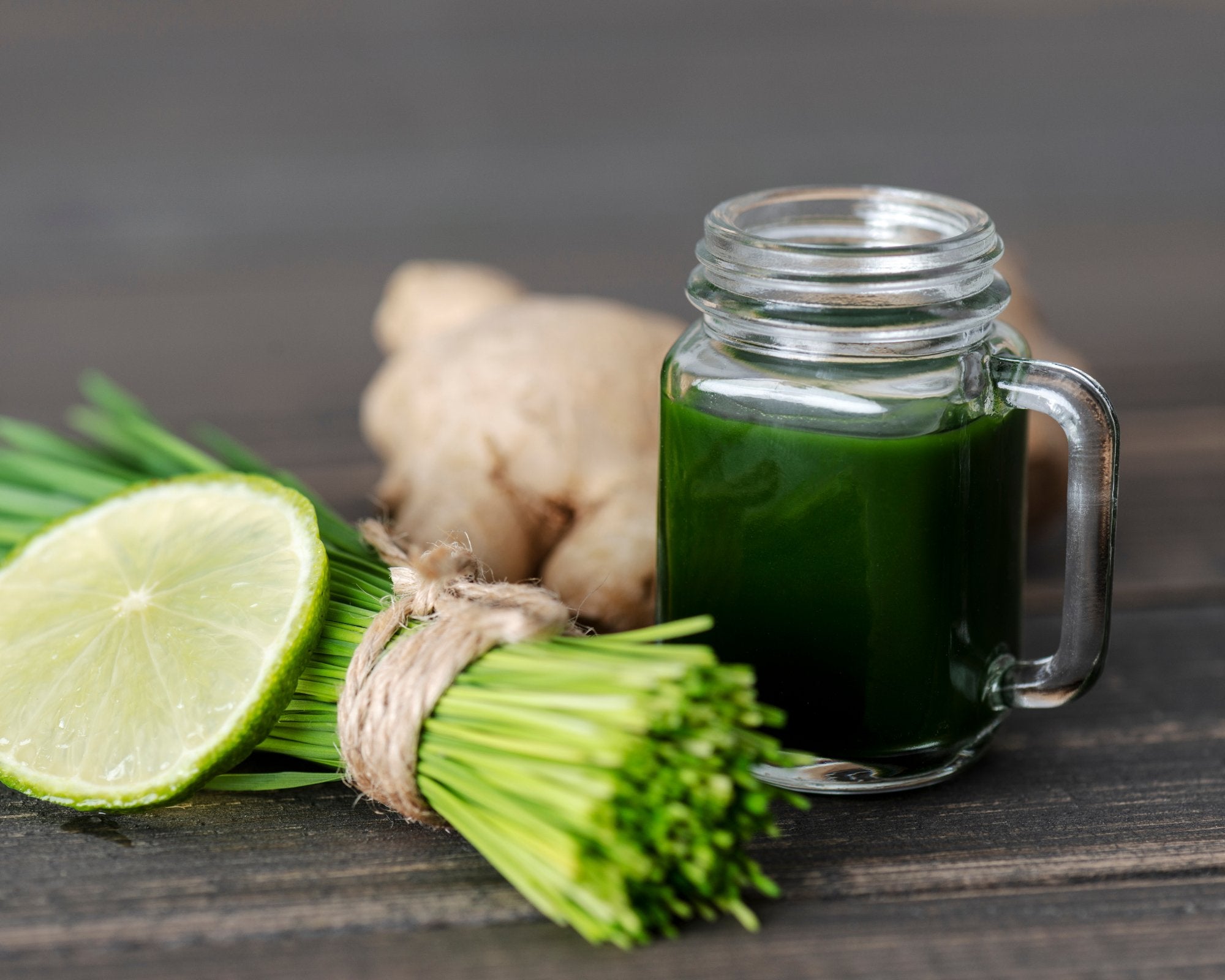Wheatgrass is a food made from the Triticum aestivum plant. It’s regarded as a super potent health food with amazing benefits.

It’s usually consumed as a fresh juice, but it also comes in powdered form. Fresh wheatgrass juice is considered to be a “living food.”
Health enthusiasts have long raved about the countless benefits of this plant, and for good reason.
It can be used as an everyday health tonic and may even help treat specific diseases. More research is needed to truly determine its efficacy, but researchers agree that wheatgrass has potential.
Keep reading to discover the possible healing benefits of wheatgrass.
1. It’s a superfood
Wheatgrass is packed with a powerful combination of nutrients, and this makes it extremely useful to your health. It has many therapeutic benefits and is known as complete nourishment.
Its extensive combination of vitamins and nutrients may make wheatgrass an exceptional choice to enhance your well-being. Wheatgrass has antioxidant, antibacterial, and anti-inflammatory properties.
It contains:
- iron
- calcium
- enzymes
- magnesium
- phytonutrients
- 17 amino acids
- vitamins A, C, E, K, and B complex
- chlorophyll
- proteins
2. It can eliminate toxins
The nutrients in wheatgrass aid your body in getting rid of impurities and stored toxins, according to 2015 research.
For example, chlorophyll aids in the removal of toxic substances and helps support healthy liver function, per a 2011 research review. Once your body is cleansed, you may see an increase in energy levels and better health overall.
3. It can help with digestion
Wheatgrass has high levels of enzymes that aid in digestion by helping your body to break down food and absorb nutrients. This can help with digestion, according to the previously mentioned 2011 research review.
The detox effects of wheatgrass clean your intestines. This helps you experience less gas, bloating, and abdominal discomfort. Wheatgrass may also help relieve constipation, irritable bowel syndrome, and other digestive issues, per the 2015 research.
4. It can boost your metabolism
Drinking wheatgrass can boost your metabolism and aid in weight loss, the aforementioned 2015 research suggests. It’s a good choice if you’re watching your weight, because it’s low in calories and has no fat.
Wheatgrass is a nutrient-dense food, leading many people to feel fuller faster and stay full for longer. This can help reduce your desire for foods that are high in sugar or fat.
5. It can lower your cholesterol
Wheatgrass is also known to lower cholesterol levels, according to a 2010 research. Losing weight can also help you lower cholesterol levels, which can make you less at risk for developing heart disease, per a 2010 study.
6. It can boost your immune system
Wheatgrass enhances the function of your immune system. This can help ward off infection and disease. Plus, you’ll likely feel better when your immunity is performing at optimal levels.
If you do get some type of illness, having a strong immune system can help you recover more quickly.
7. It can give you energy
Your energy levels may be higher than usual from the nourishment you receive. Once your body has cleared out harmful substances, your energy can be directed toward performing daily tasks and exercising. You may feel rejuvenated and refreshed.
8. It can improve cognitive function
Wheatgrass may improve overall mental function and relieve anxiety.
Its neuroprotective effects allow for better cognitive function and may help ward off and treat Alzheimer’s disease, according to a 2010 lab study.
It may also help prevent memory loss and improve hand-eye coordination.
9. It can help with diabetes
According to a 2014 animal study, wheatgrass has been shown to improve blood sugar levels in rats with Type II diabetes.
This is, in part, because wheatgrass has compounds that have an effect similar to insulin. It lowers the glycemic index of foods, which has a positive effect on blood sugar levels.
10. It can help with arthritis
Wheatgrass may have anti-inflammatory properties, according to the 2011 research mentioned earlier. This may help ease some of the symptoms of arthritis, such as stiffness, pain, and swelling. It may result in less discomfort and improved function.
Are there any side effects?
You should purchase wheatgrass only from a trusted supplier, such as a reputable health store. Talk with an associate to ensure that the plants were grown and cleaned properly. This helps to eliminate the possibility of harmful bacteria and mold.
When you first start taking wheatgrass, begin with a small dose and gradually increase your intake to meet the recommended dose. This will help your body adjust to digesting wheatgrass.
A typical liquid dose is anywhere from 1 to 4 ounces, or about 2 shots. The usual powdered dose is 3 to 5 grams, or about 1 teaspoon. Drinking an 8-ounce cup of water after taking wheatgrass can help reduce your risk for side effects.
Possible side effects include:
- nausea
- headache
- constipation
- upset stomach
- fever
- These symptoms typically fade within 2 weeks, or after your body has adjusted to the wheatgrass.
Don’t take wheatgrass if you’re pregnant or breastfeeding or chestfeeding. Allergic reactions are possible in some people, especially those who are allergic to wheat or grass. It may also affect you differently if you have a blood disorder, celiac disease, or a gluten intolerance.
Is there a link between wheatgrass and cancer?
Wheatgrass may be a powerful addition to cancer treatment plans.
The 2015 review of studies mentioned earlier suggests that wheatgrass has anticancer potential.
This could be because wheatgrass kills off certain cells. When used alongside conventional cancer treatment, wheatgrass may boost the immune system and help the body to detox. Larger studies are needed to confirm these findings.
A 2017 study found that wheatgrass has an inhibitory effect on proliferation of cells in oral cancer. This means it may stop the cells from multiplying and spreading. It may be due to its high chlorophyll content.
Wheatgrass may also lower myelotoxicity that is caused by chemotherapy. Myelotoxicity reduces bone marrow function and can increase your risk for infection.
A 2015 review also shows that wheatgrass has antioxidant properties that may help prevent cancer. The high nutritional value of wheatgrass helps to build a strong immune system, which is thought to keep the body healthy and free of disease.
The bottom line
To make the most of these benefits, try taking a serving of wheatgrass every day or every other day.
Pay attention to any changes that you notice in your body. You may wish to take notes at the end of each day to help map when you experience side effects or when you see other impact, such as an increase in energy.
It’s important to find the dosage and time of day that works for you. Trial and error can help you decide if it’s better for you to take on an empty stomach or after food.
If you’re taking wheatgrass for a specific health concern, look into other lifestyle changes that can further aid in improving your health. Your doctor may also be able to recommend specific changes in diet or routine.
Study Sources mentioned in this article:
- Bar-Sela G, et al. (2015). The medical use of wheatgrass: Review of the gap between basic and clinical applications.
pubmed.ncbi.nlm.nih.gov/26156538/ - Bar-Sela G, et al. (2007). Wheat grass juice may improve hematological toxicity related to chemotherapy in breast cancer patients: A pilot study.
tandfonline.com/doi/abs/10.1080/01635580701308083 - Das P, et al. (2016). Antioxidative and anticarcinogenic activities of methylpheophorbide a, isolated from wheat grass (Triticum aestivum Linn.)
tandfonline.com/doi/full/10.1080/14786419.2015.1022775 - Gore RD, et al. (2017). Wheatgrass: Green blood can help to fight cancer.
ncbi.nlm.nih.gov/pmc/articles/PMC5534514/ - Jang JH, et al. (2010). Neuroprotective effects of Triticum aestivum L. against beta-amyloid-induced cell death and memory impairments.
onlinelibrary.wiley.com/doi/10.1002/ptr.2871 - Khan MS, et al. (2015). Chromatographic analysis of wheatgrass extracts.
ncbi.nlm.nih.gov/pmc/articles/PMC4678994/ - Kothari S, et al. (2011). Hypolipidemic effect of fresh Triticum aestivum (wheat) grass juice in hypercholesterolemic rats.
ptfarm.pl/pub/File/Acta_Poloniae/2011/2/291.pdf - Mohan Y, et al. (2013). Antidiabetic and antioxidant properties of Triticum aestivum in streptozotocin-induced diabetic rats.
hindawi.com/journals/aps/2013/716073/ - Rana S, et al. (2011). Living life the natural way — wheatgrass and health.
functionalfoodscenter.net/files/47516971.pdf - Sethi J, et al. (2010). Antioxidant effect of Triticum aestivium (wheat grass) in high-fat diet-induced oxidative stress in rabbits.
journals.prous.com/journals/servlet/xmlxsl/pk_journals.xml_summary_pr?p_JournalId=6&p_RefId=1423889&p_IsPs=N - Shakya G, et al. (2014). Hypoglycaemic role of wheatgrass and its effect on carbohydrate metabolic enzymes in type II diabetic rats.
https://pubmed.ncbi.nlm.nih.gov/25116122/ - Yi B, et al. (2011). Inhibition by wheat sprout (Triticum aestivum) juice of bisphenol A-induced oxidative stress in young women.
sciencedirect.com/science/article/abs/pii/S1383571811002063


